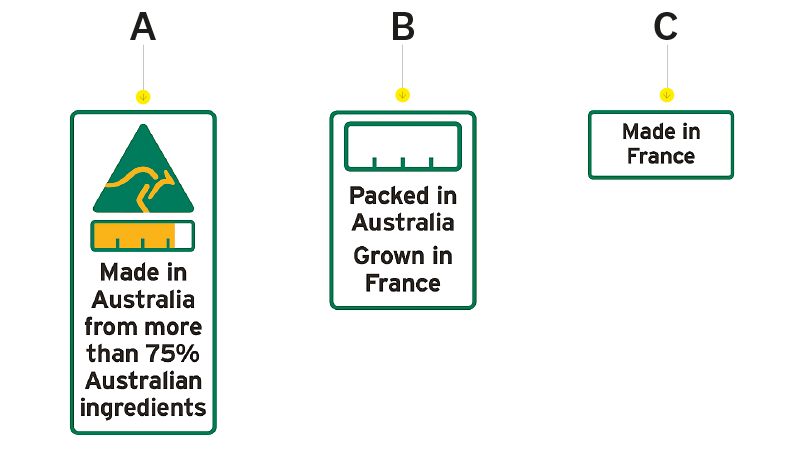Labels stating ‘grown in’, ‘produced in’, and ‘made in’ are common on food products. But they haven’t always proved palatable in the supermarket aisles, with consumers left scratching their heads over what they mean. Under new mandatory country of origin food labelling laws, those claims will be much clearer.
An outbreak of hepatitis A three years ago, caused by frozen berries imported from China, was the catalyst for changing country of origin food labelling to give consumers a better idea of where their food comes from. The Chinese berries, imported by an Australian company, were allegedly contaminated as a result of infected plant workers not washing their hands properly, or water polluted by sewage becoming involved in the processing.
 Frozen berries from Nanna’s and Creative Gourmet, grown in China, were recalled due to being contaminated with hepatitis A.
Frozen berries from Nanna’s and Creative Gourmet, grown in China, were recalled due to being contaminated with hepatitis A.
As a result of the scandal, the
Country of Origin Food Labelling Information Standard 2016 – known as the Standard for short – came into Australian Consumer Law on 1 July 2016. It regulates the country of origin information that must be provided for most food offered, or suitable for, retail in Australia.
A two-year honeymoon period has given businesses and individuals time to make the necessary changes, but that ended on 30 June. From 1 July, all businesses must label their products according to the Standard.
The Australian Competition & Consumer Commission (ACCC) will ensure compliance with the new law. Businesses that don’t comply will face penalties of up to $1.1 million for corporations and up to $220,000 for individuals.
ACCC commissioner Mick Keogh says the new labelling is much more detailed and it makes sure consumers are aware of the origin of the food. “Consumers should have certainty of what they are purchasing,” he says.
“There is endless information that highlights consumers have a bias toward locally produced foods and they are prepared to pay for it.”
For the most part, Australian producers are positive about the new label requirements, but some aren’t impressed. Smaller food producers claim changing their labels is too costly. Meanwhile, the Standard adds another layer of complexity for dairy producers, as additives to yoghurt or cheese, such as cultures or vitamins that can’t be sourced in Australia, prevent them from making a Product of Australia claim, as not 100% of the ingredients are Australian.
“We understand the issues small retailers have, but they have had two years’ notice and it is pretty important to get it right,” says the commissioner.
Timeline showing the events leading up to the Country of Origin Food Labelling Information Standard 2016.
GAINING CLEAR CONSUMER CONFIDENCE
AUSVEG national manager of communications Shaun Lindhe says the new laws will make consumers confident they have the information at hand to make a more informed choice. He says 95% of fresh vegetables sold in Australia are grown here, but more prominent labelling will boost awareness.
NSW Farmers’ Horticulture Committee chair and persimmon grower Brett Guthrey says consumers are more likely to buy something if they are aware it is of Australian origin. “What that translates to is it’s better for the consumer and better for the farmers,” he says.
*To read more about how Australian produce is received internationally as clean and safe, see our story, ‘Can the China boom last’ about the demand for Australian made products with Chinese consumers. Also read how Central West NSW beef brand, Rosedale Ruby is advancing forward in the export market with clever marketing.
Across the aisles to the meat section, fresh pork meat, whether it’s chops or a roast, is 100% Australian, says Ean Pollard, producer and NSW Farmers’ Pork Committee chair. But 70% of processed meats, such as bacon and ham, are made from imported pork and, under the old labelling, it was difficult to work out where the product came from.
“The new labels, with the picture of the kangaroo and the bar graph, tell a story without having to read a lot,” he says.”
A Department of Industry, Innovation and Science spokesperson also believes the new labels will make it easier for consumers, saying: “Food packed in Australia will show the proportion of Australian ingredients and the labels on imported food will be easier to find.”
Country of origin labelling reforms are expected to be reviewed in 2020-21.
*With price markdowns of up to 40% it’s tough going for pig producers. But one pig farmer from Young, Edwina Beveridge has created a sustainable business model by transforming waste into energy, that’s safeguarding her piggery from rising electricity prices and changing commodity values.
WHAT DO COUNTRY OF ORIGIN LABELS LOOK LIKE?

A. Three-component standard mark
Mandatory for priority food items (such as meat, fruit and vegetables, bread and dairy products) grown, produced or made in Australia.
The label includes:
- The kangaroo in a triangle symbol.
- A bar chart showing the percentage of Australian ingredients.
- Text stating ‘grown in’ or ‘product of’ Australia or ‘made in’ and the percentage of Australian ingredients.
B. Two-component standard mark
Mandatory for most priority food items packed in Australia. It may also be used for imported priority foods that contain Australian ingredients.
The label includes:
- A bar chart showing the percentage of Australian ingredients.
- Text stating ‘packed in Australia’ and indicating the proportion of Australian ingredients.
C. Country of origin statement
This label will appear on non-priority food items and has text stating the country of origin. The difference between priority and non-priority food is all about how processed an item is. A food will be a priority item unless it is in one of these non-priority categories: seasonings, confectionery, biscuits and snack food, bottled water, soft drinks and sports drinks, tea and coffee, and alcoholic beverages. Imported priority foods must also, as a minimum, carry a country of origin statement in a clearly defined box.